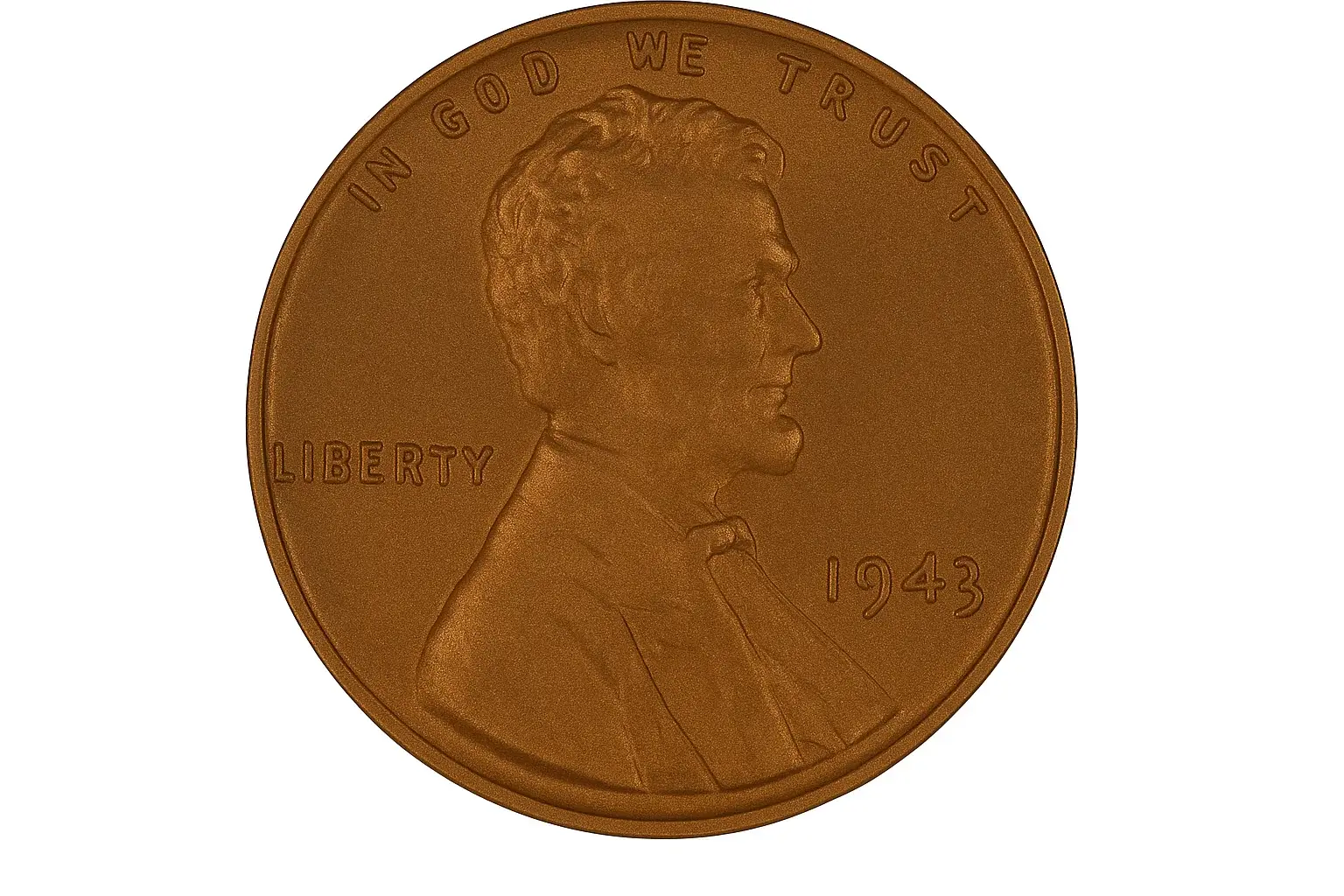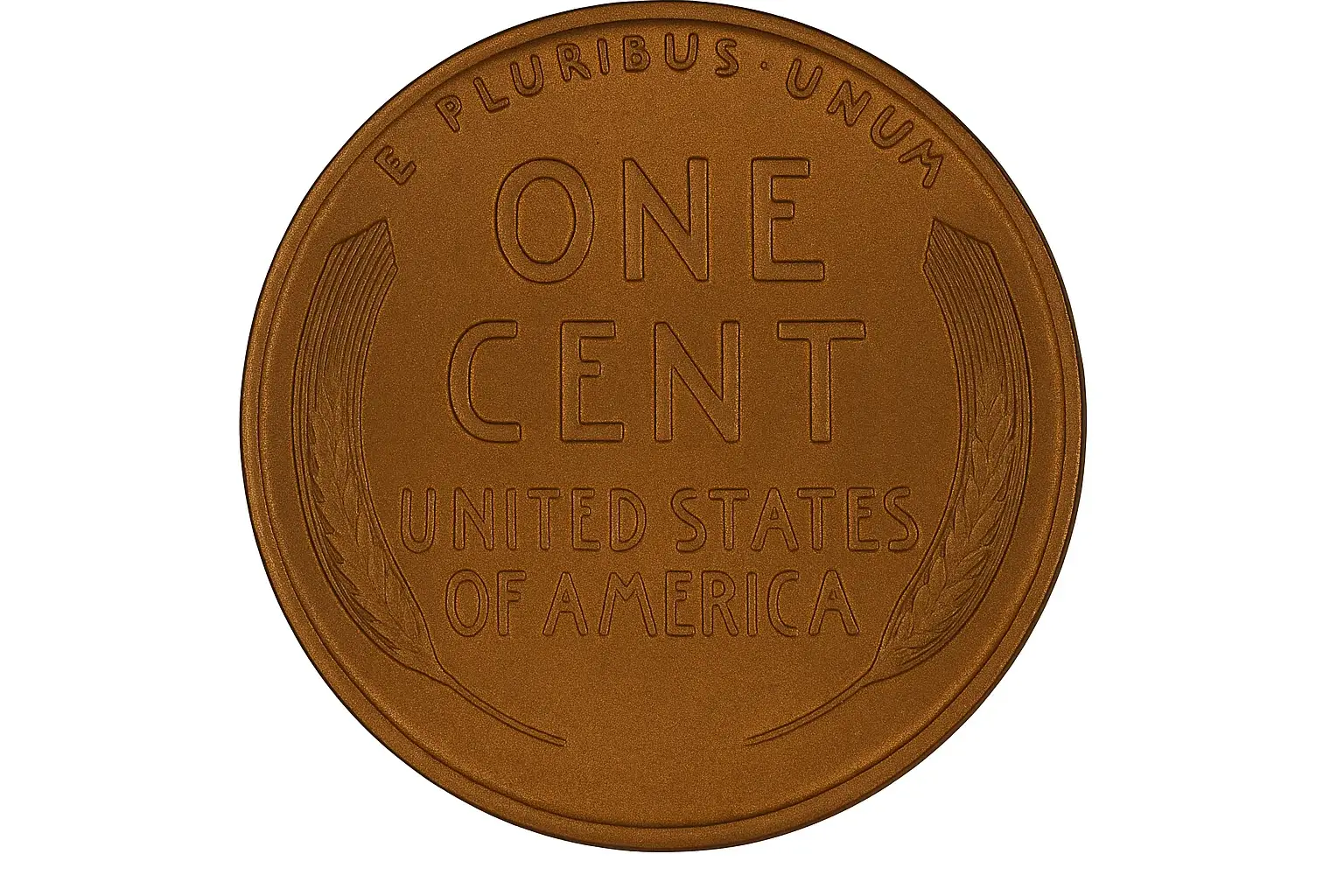A 1943 copper penny is one of the most famous and valuable error coins in U.S. history.
In 1943, the U.S. Mint switched from the usual copper alloy to zinc-coated steel for one-cent coins to save copper for World War II military production. Almost all 1943 pennies were made from steel and appear silver-gray in color.
However, a small number were mistakenly struck in copper—likely because some leftover bronze planchets (blanks from 1942) remained in the coin presses when production changed over. These rare errors entered circulation unnoticed.

Composition: About 95% copper, 5% tin and zinc (standard pre-1943 bronze alloy)
Mintage: Estimated fewer than 20 known from the Philadelphia Mint, and even fewer from Denver and San Francisco
Appearance: Similar in color to regular pre-1943 Lincoln cents, but dated 1943
Weight: Around 3.11 grams (steel cents weigh 2.7 grams)
Magnetic Test: Not attracted to a magnet (steel cents are)
1943 Copper Penny Value Table
Grade | Description | Estimated Value (USD) | Notes |
G-4 (Good) | Very worn, major details visible | $150,000 – $175,000 | Very few exist in low grades; most found by collectors early on |
VG-8 (Very Good) | Well worn, some design clear | $175,000 – $200,000 | Extremely scarce in circulated condition |
F-12 (Fine) | Moderate wear, clear details | $200,000 – $250,000 | Increasingly rare at this grade |
VF-20 (Very Fine) | Light wear on high points | $250,000 – $300,000 | Sought by mid-grade collectors |
EF-40 (Extremely Fine) | Sharp details, minor wear | $300,000 – $350,000 | Only a handful exist this sharp in circulated form |
AU-50 (About Uncirculated) | Traces of wear, nearly full luster | $350,000 – $500,000 | High demand, major jump in value |
MS-60 (Mint State) | Uncirculated, few marks | $500,000 – $650,000 | Rare; typically auctioned with fanfare |
MS-63 RB (Red-Brown) | Strong strike, mix of red & brown | $700,000 – $850,000 | Premium for eye appeal |
MS-65 RD (Full Red) | Brilliant red mint color | $900,000 – $1,200,000+ | Record auction prices; one sold for $1.7M in 2010 |
These values are for authentic 1943 copper cents only, not steel cents. Most fakes are worth only face value or a few dollars as novelties. Even damaged or corroded genuine examples can be worth over $100,000.
Comparison with Standard Ones
The ordinary 1943 penny was made from zinc-coated steel. This gives it a silvery-gray appearance and makes it magnetic. It weighs about 2.70 grams and was produced in huge quantities — over a billion coins — as part of the U.S. Mint’s wartime effort to conserve copper for military use.
The 1943 copper penny, on the other hand, is a mint error struck on leftover bronze planchets from 1942. It has a brown to reddish color, is not attracted to a magnet, and weighs about 3.11 grams. Only a tiny number exist. So, they are extremely valuable — often worth hundreds of thousands to over a million dollars at auction.
How to Spot a Fake 1943 Copper Penny
1. Use a magnet first
A genuine 1943 copper penny will not stick to a magnet. If it does, it’s a steel cent that’s been copper-plated — a common fake.
2. Check the weight
A real one should weigh about 3.11 grams. Steel cents weigh around 2.70 grams. You’ll need a precise scale that measures to at least two decimal places.
3. Look closely at the date
Many counterfeits are made by altering the date of a 1945, 1948, or other copper cent. Under magnification, the altered numbers may look uneven, with tool marks around them. The “3” in an authentic 1943 has a distinctive rounded shape and spacing that forgers often get wrong.
4. Inspect the surface
If it’s a plated steel coin, the copper layer often wears unevenly, revealing gray metal underneath. A true copper coin will be the same reddish-brown metal all the way through.
5. Get professional authentication
Because high-quality fakes exist, even coins that pass home tests should be sent to a reputable grading service like PCGS or NGC for certification.

Values Predictions
The 1943 copper penny has shown a steady upward trend in value over the past few decades, driven by extreme rarity, strong collector demand, and increasing media coverage of major sales. Here’s the outlook for the next five years based on historical price movements, auction records, and overall market sentiment in rare U.S. coins:
Current Range (2025)
Circulated: $150,000 – $350,000
Mint State: $500,000 – $1.2M+
Predicted Value Trends
2026: Slight increase, fueled by continued collector competition and limited supply. Expect a 5–10% rise.
2027: Possible record sales at major auctions like Heritage or Stack’s Bowers; high-end pieces may push above $1.5M.
2028: If bullion and rare coin markets stay strong, circulated examples could average $200K+, Mint State could approach $1.7M.
2029: Media exposure (TV shows, documentaries, viral stories) could cause a speculative jump, pushing top examples toward $2M.
2030: Stable but high prices; market likely settles with circulated pieces at $250K–$400K and top-tier Mint State at $1.8M–$2M.
Why the Increase Is Likely
Extremely limited population (fewer than 30 known across all mints).
Each auction sale generates headlines, attracting new collectors.
Rare U.S. error coins tend to appreciate even in broader economic downturns.
Year-by-year Value Projection
Circulated (VF–EF Range)
Year | 1943 (No MM) | 1943-D | 1943-S |
2025 | $150K – $300K | $700K – $1M | $350K – $600K |
2026 | $160K – $315K | $750K – $1.05M | $365K – $625K |
2027 | $170K – $330K | $800K – $1.1M | $380K – $650K |
2028 | $180K – $350K | $850K – $1.2M | $400K – $675K |
2029 | $190K – $370K | $900K – $1.3M | $420K – $700K |
2030 | $200K – $400K | $950K – $1.4M | $450K – $750K |
Mint State (MS-63 to MS-65 RD)
Year | 1943 (No MM) | 1943-D | 1943-S |
2025 | $500K – $1.2M | $1.5M – $2.1M | $900K – $1.5M |
2026 | $525K – $1.25M | $1.55M – $2.2M | $950K – $1.55M |
2027 | $550K – $1.3M | $1.6M – $2.3M | $1M – $1.6M |
2028 | $575K – $1.35M | $1.65M – $2.4M | $1.05M – $1.65M |
2029 | $600K – $1.4M | $1.7M – $2.5M | $1.1M – $1.7M |
2030 | $625K – $1.45M | $1.75M – $2.6M | $1.15M – $1.75M |
1943-D copper cents are the rarest — only one confirmed example — hence their steep value curve.
1943-S is rarer than Philadelphia but not as elusive as Denver.
All three types are expected to appreciate steadily due to near-zero chance of new discoveries.
What Experts Say
From an expert’s perspective, the value trajectory looks strong for the next decade. Even in volatile economic periods, elite-tier numismatic rarities tend to outperform common collectibles because they attract wealthy private collectors and institutional buyers who view them as tangible assets. This is especially true for coins like the 1943 copper penny, where the number of possible trades is limited by sheer scarcity.
The Denver variety is likely to see the most aggressive price growth, given its one-of-a-kind status, while Philadelphia and San Francisco examples will continue to climb steadily. The main risk is not in value loss, but in authentication — counterfeits are rampant, and only coins certified by PCGS or NGC should be considered for serious investment.

 Bonjour! I am Mathieu Lefebvre, I am a French national taking medicine in the United States. I took a great interest in alternative medicine since they are very prevalent here in the United States than in my native country! Though they are not really taught in our school that extensively, I find myself learning about them for the sake of knowledge!
Bonjour! I am Mathieu Lefebvre, I am a French national taking medicine in the United States. I took a great interest in alternative medicine since they are very prevalent here in the United States than in my native country! Though they are not really taught in our school that extensively, I find myself learning about them for the sake of knowledge!